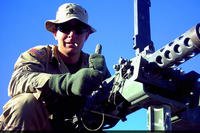On Jan. 17, 1991, the first night of Operation Desert Storm, Lt. Cmdr. Michael Scott Speicher took off from the flight deck of the USS Saratoga in his F/A-18 Hornet. He was the first casualty of the war and was never seen alive again. For years, the U.S. Navy maintained that he'd been shot down by a surface-to-air missile. His wingmen swore it was an Iraqi MiG fighter. At the outset, the only thing anyone knew for sure was that he -- or his remains -- were missing in action.
At that time, Steve Dwyer was serving with the 82nd Aviation Brigade as an operations research systems analyst, stationed near the small Saudi Arabian town of Rafha, near the border with Iraq. When news of Speicher's incident broke, his unit was put on standby to help with the recovery effort. Today, he is retired from the Army.
His son, Chief Warrant Officer 3 Steven Dwyer of the 160th Special Operations Aviation Regiment (SOAR), died in November 2023 when his helicopter crashed during an exercise in the Mediterranean Sea. The story of the search for Scott Speicher gave the elder Dwyer new meaning after his son also died in the service of his country.
Read Next: Army Identifies 5 Special Operations Soldiers Killed in Black Hawk Crash in Mediterranean Sea
"When we got the news [about Speicher], we began getting involved in figuring out how to recover him," Dwyer told Military.com. "There were all kinds of rumors about what would happen if you got shot down. We heard that captured pilots were going to be eaten. That was the rumor. We didn't want anything to happen to anybody. So there was a lot of effort on combat search and rescue. Every mission that we went on, we were thinking, 'Hey, I'll get you. If you get shot down, I'll come get you.'"

Speicher was listed as "Missing In Action" the next day. On May 22, 1991, with no credible evidence the naval aviator survived being shot down, he was reclassified "Killed in Action/Body Not Recovered" (KIA/BNR). That was far from the end of his story. When the war ended six weeks later, the Iraqi government turned over human remains it said were from a downed pilot, but the tissue samples weren't a match for Speicher.
Two years later, a group of Iraqi hunters near Tulul ad Dulaym in Iraq's Anbar Province stumbled upon the wreckage of an F/A-18 Hornet, wreckage that included the canopy and clear evidence that Speicher ejected from the aircraft. Dwyer, then an aviator with the 160th SOAR, was put on standby to plan and attempt an operation to go into Iraq, with or without Saddam Hussein's permission, and rescue Speicher.
"This mission was very hush, hush," he recalled. "They found these Bedouin hunters were wandering through the desert and came upon evidence that he's [Speicher] still alive. This is years after, and we were figuring, man, he's in bad shape. We all know, at least in a training environment, what it's like to be a prisoner of war. So we were very enthusiastic about the mission. It was going to be a bunch of [MH-6] Little Birds flying across the border, some Black Hawks, but the Little Birds were with special operations folks, and they were going to get out, get the evidence and then go find him."
Dwyer was set to be the alternate air mission commander for the rescue, but it was scrubbed by the Pentagon after being deemed too risky. It wasn't until 1995 that U.S. officials and the International Committee of the Red Cross were allowed to enter Iraq to visit the crash site. The locals gave investigators the remains of a flight suit that purportedly belonged to Speicher, but quickly determined it was planted evidence. They did determine conclusively that he had ejected successfully. There were no human remains at the site.
"We were going to go in without asking, because photos were telling us there were two pieces [of the plane] there, the cockpit and the seat," said Dwyer. "But the pilot wasn't there, so we were in the process of trying to find evidence that would indicate that the Iraqis had taken him somewhere and hidden him. We were hopeful that something would come of that."

But nothing came of it. By January 2001, the downed aviator's status was changed once again, this time to "Missing/Captured." In 2002, an Iraqi defector reported that he'd personally driven an American pilot at Iraqi Intelligence Headquarters in Baghdad and that the prisoner was "in good health, but walked with a limp and facial scars."
After the 2003 U.S.-led invasion of Iraq, the United States had broader access to Iraq and former Iraqi facilities. In April 2003, U.S. troops not only looked for weapons of mass destruction, they renewed their search for evidence of Speicher. That came in the form of the letters "MSS" scrawled on a prison cell wall in Baghdad, a clear standout from the Arabic graffiti that dominated the cells. Speicher, being trained in evasion and escape techniques, would have known to place evidence of his survival wherever he could.
It wasn't until July 2009 that a tip from an Iraqi civilian led Marines from Task Force Personnel Recovery of the Multi-National Force-West to begin excavating the Speicher crash site. In August, they found human remains that were later determined to be those of Speicher, the first Navy aviator shot down during the war. A jawbone confirmed his identity. Locals said his remains were buried by Bedouins shortly after the shootdown. The discovery brought an end to the 18-year mystery.

"I felt like we were going to do something important, especially if we could find him," Dwyer recalled. "Man, when you think about it, it's so frustrating. We don't fight for anything but the people in it with you. You don't think about the flag, you don't think about anything except the people that are there with you, and that's who we were in it for. We were in it for Speicher and his family. Now I'm a Gold Star father, I know exactly what it feels like, and it's very painful. It's forever painful. And I know that his wife and kids, the pain they felt, plus not knowing what happened to him.

"For two months, my son was 3,000 feet below the surface in the Mediterranean," Dwyer continued. "They did everything they could to bring him back, which they finally did. I know what the efforts that people will go [are]. If somebody called me back off of retirement and said, 'We need you to help find somebody or go rescue somebody that's been captured,' I would do it. I'm 66. That's the feeling that you get when you get called to try to help a fallen comrade."
As for how Speicher was shot down, authors Douglas C. Dildy and Tom Cooper interviewed Iraqi MiG-25 Foxbat pilot Lt. Zuhair Dawoud for their book, "F-15C Eagle vs MiG-23/25: Iraq 1991." In it, Dawoud describes taking off from Qadessiya Air Base on Jan. 17, 1991, taking out an F/A-18 Hornet with an R-40 missile that exploded beneath the cockpit. Speicher had ejected, but died shortly after.
Want to Learn More About Military Life?
Whether you're thinking of joining the military, looking for post-military careers or keeping up with military life and benefits, Military.com has you covered. Subscribe to Military.com to have military news, updates and resources delivered directly to your inbox.




















